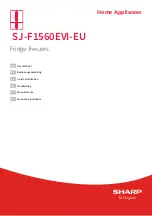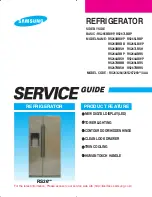
EN -13-
CHAPTER -3: USING YOUR FRIDGE FREEZER
10. Do not leave too much air in the bag. Before the bag is placed in the compartment, remove any excess air by
squeezing the surface of the bag as hard as possible. Otherwise the vacuum pump may not vacuum all of the air
out of the bag.
11.
Sharp-edged materials must not be vacuumed. They may pierce the bag while vacuuming and the operation will
not complete. (Fishbone, hard-shelled foods, etc.).
12. If the vacuum bags are to be re-used for food, it can be cut by scissors on the red line (1 cm below the melted
mouth). It must not be re-used for new food, only residue food can be used again. Example of Incorrect Use:
Open the mouth of the bag containing salami and then put cheese into the bag is wrong. This usage may result
in the mixing of smells between the two foods and deteriorate the cheese. Example of Correct Use: Open the
mouth of the bag containing salami and then after consuming, return some of the salami back into the bag.
During these operations, the environment and hands should be clean and hygienic.
13. VacPac Pro technology helps maintain the freshness of the food under proper storage conditions. Vacuuming
should be done for the freshest foods possible. Older food and food residues should not be vacuumed.
14. Do not use vacuum bags in the microwave or oven.
15.
It is recommended to store granulated foods (semolina, bulgur, flour etc.) without vacuuming. If some foods
in granular form are to be vacuumed, it is recommended that they should be covered by paper towels or filter
paper.
16. It is recommended that wet-surfaced food such as hamburger patties or pancakes which can possibly stick
together should not be vacuumed without placing greaseproof paper between them.
17.
Before vacuuming soup, casserole or succulent foods, they should be frozen in an unbreakable container then
put into the bag. After that they should be stored in a freezer compartment.
18. When it is desired to vacuum the large volume foods and the vacuum process is not completed, it is
recommended to repeat the process by leaving a gap at the bottom and side edges of the bag.
Food Storage Recommendations
Recommendations to be taken into consideration for the storage of foods after the vacuuming process is finished are
stated below.
1. Before vacuum sealing, it’s necessary to clean your hands, and all utensils and surfaces to be used for cutting and
vacuum sealing foods.
2. If perishable foods have been heated, defrosted or unrefrigerated, consume them immediately. Refrigerate or
freeze the perishable foods immediately after you have vacuum-sealed them, and do not leave them sitting at
















































